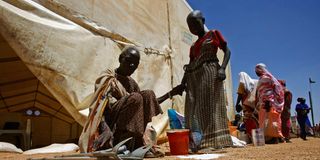Sudan-South Sudan border dispute rages on 10 years since war

South Sudanese refugees are seen at a "Refugee Waiting Centre" in Al-Eligat area along the border in Sudan's White Nile state on February 27, 2017. A decade after separating, Sudan and South Sudan are still arguing about where the boundary lies.
Eleven years after South Sudan separated from the previous larger Sudan, the two countries are still arguing about where the boundary lies.
While they agreed to open borders in October 2021, they differ on the exact borderline and crossing points are yet to open.
Officials are concerned that despite the agreement to open four border points for free movement of people and goods, communal land issues had blocked cross-border trading.
The two countries are suffering from the effects of not implementing the 2005 Comprehensive Peace Agreement. They dispute several border crossing points, undermining trade.
Last year’s agreement specified that four crossing posts closed when a war broke out in 2013 be opened. They are Jebelain-Renk, Meiram, Buram -Timsah and Kharsana-Panakuac.
But the crossing points remain closed. One of the obstacles is the local population, said Sudan’s ambassador to South Sudan Jamal Malik.
"It appears that some people do not want those crossing points to be opened due to land disputes, so the two countries must work harder to persuade those people," he said.
Both countries were devastated by the closure of the crossing points. South Sudan is landlocked and relies on crude oil exports through Sudan. For its part, Sudan had relied on fees from South Sudan’s exports of oil and consumable goods to South Sudan.
There are 11 border states – five in South Sudan and six in Sudan. They may constitute roughly half of the population of the two countries. The countries’ border is neither defined nor delimited.
The Sudan 2005 peace pact established mechanisms for delimiting and demarcating borders. But the process failed because the parties were unable to reach a political agreement on contested border areas.
When South Sudan gained independence in 2011, its border with its northern neighbour was officially established. The two countries went to war in 2012 over the disputed oil-rich area of Heglig, which is on the border. This triggered the closure of the border, disrupting cross-border movement.
Also Read: Blinken, Omamo discuss regional security
Despite the closure, traders and Arab pastoralists devised informal trade and movement routes. The African Union also intervened, mediating a "soft border" agreement, which was signed in 2012.
The two countries also agreed to form high-level committees to address the status of the Abyei area. Because it straddles the border and has rich oil reserves, Abyei is economically desirable for both countries and critical for border stability.
The push to open the borders began in 2019 after a popular uprising in Sudan that ousted Omar al-Bashir in 2019. The new political environment was aided further by Sudan's new leadership, led by former Prime Minister Abdalla Hamdok, an experienced economist who worked for the UN for over two decades.
The closure of border crossings has significantly disrupted trade and people movement, says Tong Akeen Ngor, governor of Northern Bahr el Ghazal state. For example, he claims that reopening the two roads between Meram and Majok and Gok-Dhein would facilitate the movement of goods and services.





